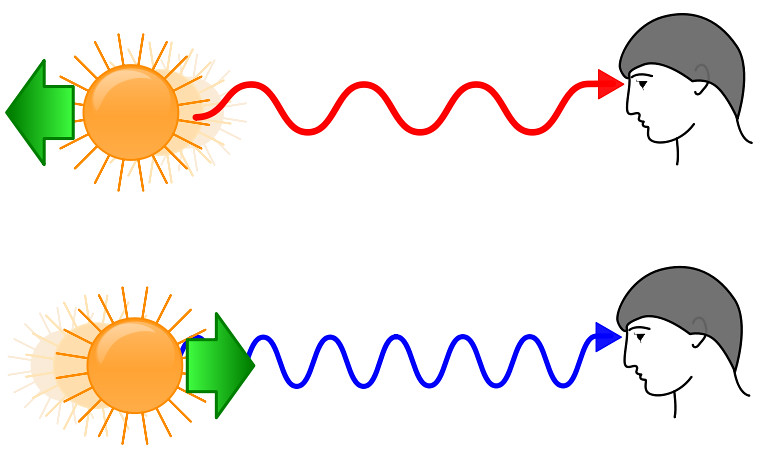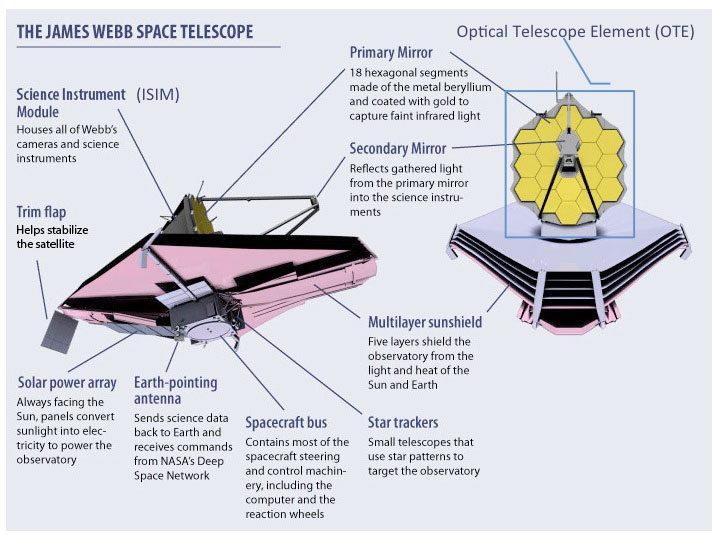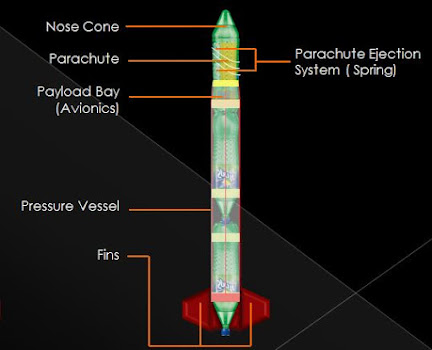James Webb Space Telescope | The Telescope That's Going to Discover The Undiscovered! Mission Report #1
Image credits: NASA
The James Webb Space Telescope (also called JWST) is an orbiting infrared observatory that will complement and extend the discoveries of the Hubble Space Telescope, with longer wavelength coverage and greatly improved sensitivity. The longer wavelengths enable Webb to look much closer to the beginning of time and to hunt for the unobserved formation of the first galaxies, as well as to look inside dust clouds where stars and planetary systems are forming today.
Credits: NASA
Science
The James Webb Space Telescope will be a giant leap forward in our quest to understand the Universe and our origins. Webb will examine every phase of cosmic history: from the first luminous glows after the Big Bang to the formation of galaxies, stars, and planets to the evolution of our own solar system.
Early universe
Webb will be a powerful time machine with infrared vision that will peer back over 13.5 billion years to see the first stars and galaxies forming out of the darkness of the early universe.Why Infrared?
Imagine light leaving the first stars and galaxies nearly 13.6 billion years ago and traveling through space and time to reach our telescopes. We're essentially seeing these objects as they were when the light first left them 13.6 billion years ago. By the time this light reaches us, its colour or wavelength has been shifted towards the red, something we call a "redshift." Why? In this particular case, it's because when we talk about very distant objects, Einstein's General Relativity comes into play. It tells us that the expansion of the universe means it is the space between objects that actually stretches, causing objects (galaxies) to move away from each other. Furthermore, any light in that space will also stretch, shifting that light's wavelength to longer wavelengths. This can make distant objects very dim (or invisible) at visible wavelengths of light, because that light reaches us as infrared light.
Imagine light leaving the first stars and galaxies nearly 13.6 billion years ago and traveling through space and time to reach our telescopes. We're essentially seeing these objects as they were when the light first left them 13.6 billion years ago. By the time this light reaches us, its colour or wavelength has been shifted towards the red, something we call a "redshift." Why? In this particular case, it's because when we talk about very distant objects, Einstein's General Relativity comes into play. It tells us that the expansion of the universe means it is the space between objects that actually stretches, causing objects (galaxies) to move away from each other. Furthermore, any light in that space will also stretch, shifting that light's wavelength to longer wavelengths. This can make distant objects very dim (or invisible) at visible wavelengths of light, because that light reaches us as infrared light.
Redshift Illustration | Image credits: NASA
Electromagnetic Spectrum | Image credits: NASA
Galaxies Over Time
Looking at galaxies is a useful way to see how matter is organized on gigantic scales, which in turn gives us hints as to how the universe evolved. The spiral and elliptical galaxies we see today actually evolved from different shapes over billions of years, and one of JWST's goals is to look back at the earliest galaxies to better understand that evolution. Scientists are also trying to figure out how we got the variety of galaxies that are visible today, and the current ways that galaxies form and assemble. It also helps us understand the role of Dark Matter in the formation of galaxies.
Here are a few videos about how JWST will help us to better understand galaxy collisions, galaxy formation, and the evolution of the early universe.
Credits: James Webb Space Telescope (JWST)
Star Lifecycle
While this image of 'Pillars of Creation' Nebula is spectacular, there are actually stars that Hubble can't see inside those pillars of dust. And that's because the visible light emitted by those stars is being obscured by the dust. But if we used a telescope sensitive to infrared light to look at this nebula, then we can study the stars inside the dusts of galaxies and nebulas.
 The Pillars of Creation in the Eagle Nebula captured in visible light by Hubble. Credits: NASA
The Pillars of Creation in the Eagle Nebula captured in visible light by Hubble. Credits: NASA
Webb's amazing imaging and spectroscopy capabilities will allow us to study stars as they are forming in their 'dusty cocoons'. Additionally, it will be able to image disks of heated material around these young stars, which can indicate the beginnings of planetary systems, and study organic molecules that are important for life to develop.
ALMA image of the young star HL Tau and its protoplanetary disk. This best image ever of planet formation reveals multiple rings and gaps that herald the presence of emerging planets as they sweep their orbits clear of dust and gas. Credits: NASA

This video shows how JSWT will peer into dusty knots where the youngest stars and planets are forming. Credits: James Webb Space Telescope (JWST)
Other Worlds
One of the main uses of the James Webb Space Telescope will be to study the atmospheres of exoplanets, to search for the building blocks of life elsewhere in the universe.One method Webb will use for studying exoplanets is the transit method, which means it will look for dimming of the light from a star as its planet passes between us and the star. (Astronomers call this a "transit".) Collaboration with ground-based telescopes can help us measure the mass of the planets, via the radial velocity technique (i.e., measuring the stellar wobble produced by the gravitational tug of a planet), and then Webb will do spectroscopy of the planet's atmosphere.
Webb will also carry coronagraphs to enable direct imaging of exoplanets near bright stars. The image of an exoplanet would just be a spot, not a grand panorama, but by studying that spot, we can learn a great deal about it. That includes its color, differences between winter and summer, vegetation, rotation, weather etc. This can be done by spectroscopy.
JSWT will also be used for studying our own solar system in detail. Webb will observe Mars and the giant planets, minor planets like Pluto and Eris - and even the small bodies in our solar system: asteroids, comets, and Kuiper Belt Objects.
Webb will also carry coronagraphs to enable direct imaging of exoplanets near bright stars. The image of an exoplanet would just be a spot, not a grand panorama, but by studying that spot, we can learn a great deal about it. That includes its color, differences between winter and summer, vegetation, rotation, weather etc. This can be done by spectroscopy.
JSWT will also be used for studying our own solar system in detail. Webb will observe Mars and the giant planets, minor planets like Pluto and Eris - and even the small bodies in our solar system: asteroids, comets, and Kuiper Belt Objects.
Credits: James Webb Space Telescope (JWST)
Observatory
The Observatory is the space-based portion of the James Webb Space Telescope system. It is comprised of the Optical Telescope Element (OTE), the Integrated Science Instrument Module (ISIM), the sunshield and the spacecraft bus.
Credits: NASA
The OTE is the eye of the Observatory. It consists of the mirrors and the backplane. The OTE gathers the light coming from space and provides it to the science instruments located in the ISIM. The backplane is like the "spine" of Webb. It supports the mirrors.
The ISIM contains Webb's cameras and instruments. It integrates four major instruments and numerous subsystems into one payload.
The sunshield separates the observatory into a warm sun-facing side (spacecraft bus) and a cold anti-sun side (OTE and ISIM). The sunshield keeps the heat of the Sun, Earth, and spacecraft bus electronics away from the OTE and ISIM so that these pieces of the Observatory can be kept very cold (The operating temperature has to be kept under 50 K or -370 deg F).
The spacecraft bus provides the support functions for the operation of the Observatory. The bus houses the six major subsystems needed to operate the spacecraft: the Electrical Power Subsystem, the Attitude Control Subsystem, the Communication Subsystem, the Command and Data Handling Subsystem, the Propulsion Subsystem, and the Thermal Control Subsystem.
Credits: NASA
- The Observatory consists of:
- The Optical Telescope Element (OTE) includes:
- The Integrated Science Instrument Module (ISIM) contains these instruments:
- Mid-Infrared Instrument (MIRI)
- Near-Infrared Spectrograph (NIRSpec)
- Near-Infrared Camera (NIRCam)
- Fine Guidance Sensor/ Near InfraRed Imager and Slitless Spectrograph (FGS-NIRISS)
- Other elements include:
- The momentum flap balances the solar pressure on the sunshield, like a trim flap in sailing. It's not adjustable on orbit, but it is while it's on the ground.
- The Earth-pointing antenna sends science data back to earth and receives commands from NASA's Deep Space Network.
- The solar array is always facing the sun to convert sunlight to electricity to power the Observatory.
- The star trackers are small telescopes that use star patterns to target the observatory.
Launch
The James Webb Space Telescope will be launched on an Ariane 5 rocket. The launch vehicle is part of the European contribution to the mission. The Ariane 5 is one of the world's most reliable launch vehicles capable of delivering Webb to its destination in space. The European Space Agency (ESA) has agreed to provide an Ariane 5 launcher and associated launch services to NASA for Webb.
Tentative Launch Date: November 2021
Orbit
JSWT will orbit the sun 1.5 million kilometers away from the Earth at what is called as the second langrage point or L2 (Images not to scale. Credits: NASA
JSWT's orbit around the Sun at L2. Credits: James Webb Space Telescope (JWST)
Conclusion
This whole mission is a very useful and valuable mission for astronomers and scientists. This mission will help us to understand this universe in a better way and feed Humanity's curiosity with some exciting discoveries."Somewhere, something incredible is waiting to be known" - Carl Sagan
References
For further more information regarding this mission, click here.
References
For further more information regarding this mission, click here.











Comments
Post a Comment